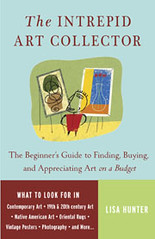Tina now hangs in my bedroom at the foot of my bed. Tina is a painting done by Paolo, my ex-lover of eight years and the emotional and sentimental favorite among my varied works of art (I suppose I refer both to the painting and Paolo.) Tina, Paolo’s muse and my competition, is the subject and the meaning of the painting. Tina is the reason the love of my life and I didn’t survive in a relationship.

I surprised Paolo one evening, arriving home a day early from a business trip. A classic set up. I was asking for it and I knew it. His drug habit and infidelity were no secret and just something that we worked around. In fact, we had been working to incorporate the infidelity into our sex life. Tina was another matter and eventually she beat me hands down. I despised Tina: The severe mood swings, the rages, the depressions, the lunacy. But I was no match for her influence. Like too many artists, Paolo could not find his muse without drugs or alcohol. Part of me was fascinated by this dynamic, and also oftentimes sexually aroused–which pathetically helped enable my lover’s drug habit. But Paolo’s use of crystal methamphetamine, known as Tina to her closest friends, eventually drove a wedge between us.
So I knew and I knew even more than Paolo realized I knew. However on that particular evening my premature return home delivered huge surprises for both of us. Yes, indeed, I did “catch” him, but not in the “anticipated” sense.
I walked through the door, and looked directly down the hall into our living room, our newly remodeled living room, I might add, and remodeled in my absence. I later learned that most of the furniture had been piled up in the guest room and not, fortunately, carried away by the Salvation Army or an antiques dealer.
Around the perimeter of the living room, Paolo had propped up a total of nine mirrors including the six bathroom cabinet doors. If nothing else, Tina was the mistress of industry. In one corner of the room, he had placed the TV and VCR on a cart and  was playing porn, Ken Ryker to be precise. I remember this for a very good reason, as you will discover. Paolo had positioned his easel in the exact center of the room. He was hard at work on Tina, wearing nothing but a beret (a little affectation of his), a Marlboro Light dangling from his lips, paint smudges wherever he had rubbed or scratched himself and, uh, a significant representative part of porn star Ken Ryker. Paolo was athletically squatting over a stone pedestal from our garden that had a Ken Ryker Signature Collection 9 1/2 Insertable Inches Dildo stuck to the top. Mounted on this enormous sex toy, Paolo was riding it slowly up and down while he painted, smoked and listened to the actual Ken Ryker grunting and groaning on the television set off to the side of the room. The mirrors were of course positioned so that wherever Paolo looked, he would see a reflection of some angle of himself riding Ken Ryker’s plastic penile doppelganger.
was playing porn, Ken Ryker to be precise. I remember this for a very good reason, as you will discover. Paolo had positioned his easel in the exact center of the room. He was hard at work on Tina, wearing nothing but a beret (a little affectation of his), a Marlboro Light dangling from his lips, paint smudges wherever he had rubbed or scratched himself and, uh, a significant representative part of porn star Ken Ryker. Paolo was athletically squatting over a stone pedestal from our garden that had a Ken Ryker Signature Collection 9 1/2 Insertable Inches Dildo stuck to the top. Mounted on this enormous sex toy, Paolo was riding it slowly up and down while he painted, smoked and listened to the actual Ken Ryker grunting and groaning on the television set off to the side of the room. The mirrors were of course positioned so that wherever Paolo looked, he would see a reflection of some angle of himself riding Ken Ryker’s plastic penile doppelganger.

